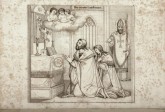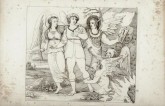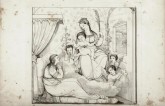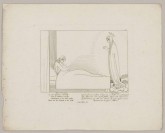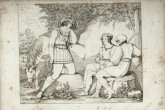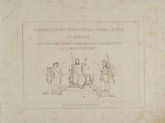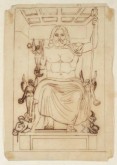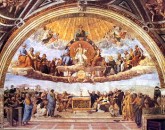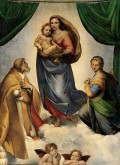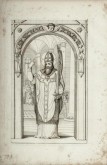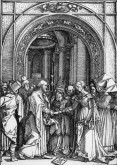The browser will either open the file, download it, or display a dialog.
Introduction
The young and ambitious Riepenhausen brothers, Franz (1786–1831) and Johannes (1787–1860),[1] first gained public attention in January 1804 when they were mentioned in the Jenaische Allgemeine Literatur-Zeitung, one of the most influential German-speaking intellectual newspapers in the early nineteenth century. No less a person than Johann Wolfgang von Goethe (1749–1832), the most famous German poet and most recognized art critic around 1800, had written a review for the paper of their twelve drawings reimaging the lost wall paintings on the right-hand side of the Cnidian Lesche in Delphi by the famous Greek painter Polygnotus (fifth century BCE).[2] The drawings were based on a detailed description by the Greek travel writer Pausanias (ca. 115–ca. 180) in his Description of Greece. A supporter of Classicism, Goethe approved of the Riepenhausens’ aim to visualize an ancient work of art that no longer existed, and he even asked them to etch and to publicize their compositions.[3] The Riepenhausen brothers responded to his request in the following year,[4] publishing their Gemählde des Polygnots in der Lesche zu Delphi (Polygnotus’s paintings in the Lesche in Delphi), which consists of two volumes: one contains their fifteen etchings representing the aftermath of the Battle of Troy,[5] the other a 41-page long commentary on the art of Ancient Greece in general and of Polygnotus in particular.[6] Although this text was published as if authored by the young artists, it is assumed that their friend Christian Friedrich Schlosser (1782–1829), the nephew of Goethe’s brother-in-law, wrote it.[7] He may not have wanted to be named as he probably feared the critique of his famous relative. Indeed, in his review of the Riepenhausens’ etchings, Goethe praised the pictures,[8] but harshly criticized this commentary.[9] He mainly disliked that the Riepenhausen brothers, obviously influenced by Romantic literature,[10] put the perfection of ancient art—the ideal of Classicism—in question stating that ancient artists—in the absence of Christian religion—had not been able to reflect the world in its entirety in their works.[11]
In the text, the Riepenhausen brothers announced that they would publish a second set of etchings reconstructing Polygnotus’s paintings on the left wall of the Lesche in Delphi, also to be accompanied by a commentary, this one dealing with the difference between ancient and Romantic art.[12] But they did not carry out that project. Instead, in 1806, they published fourteen etchings illustrating the drama Leben und Tod der heiligen Genoveva (Life and death of Saint Genevieve) by the Romantic poet Ludwig Tieck (1773–1853).[13] Although at first sight the Genevieve etchings do not seem to differ much stylistically from those “reproducing” Polygnotus’s wall paintings (in both cycles, an outline style is used), Goethe saw them as quite different. Indeed, Goethe felt that the Riepenhausen brothers, in their etchings, had given visual form to Romanticism, which was first of all a literary invention.[14] It thus seems that the Riepenhausen brothers, instead of making a verbal comparison of Classical and Romantic art, as they had announced, made a visual one.
In this article, I shall demonstrate how the fourteen Genevieve etchings reflect and visualize Romantic art theory. Comparing them with the writings of the most influential early Romantic art theorists; Ludwig Tieck, Wilhelm Heinrich Wackenroder (1773–98), and the Schlegel brothers, August Wilhelm (1767–1845) and Friedrich (1772–1829), I will ask and answer the following questions: Why did Franz and Johannes Riepenhausen choose Tieck’s Life and Death of Saint Genevieve as their subject? Why did they make use of an outline style in their etchings? Why did they combine fragments of works of former artists in their etchings?
The Choice and Interpretation of Tieck’s Life and Death of Saint Genevieve
Ludwig Tieck had published his drama Life and Death of Saint Genevieve in 1800 in the second volume of his anthology Romantische Dichtungen,[15] the title of which, Romantic Poetry, had helped to establish the term “Romanticism” in the German-speaking world.[16] Furthermore, Life and Death of Saint Genevieve was hailed as the first true Romantic drama because of its setting in the Middle Ages and its celebration of the Christian faith.[17] For his drama, the poet had adapted the story of the legendary Saint Genevieve of Brabant,[18] which takes place in the Rhineland of the eighth century:
Young and devout Genevieve is happily married with the Count Palatine of the Rhine until her husband leaves their home to support Charles Martel in fighting against the Moors. During her husband’s absence, Genevieve has to repel the advances of the Count’s young friend, Golo, who passionately loves her. In order to take revenge for her rejection, he falsely accuses her of adultery. Owing to his slander, she is condemned to live with her new-born child in the woods. But God saves her because of her many virtues, sending her a doe that suckles her little son. While hunting that doe, her husband, by chance, discovers Genevieve after seven years in the wilderness. Now that he is convinced of her innocence, he apologizes to her and takes her and their child back to his castle, where she dies shortly after. Upon her death, people start to adore Genevieve of Brabant as a saint due to her virtues and the celestial miracles that happened to her.[19]
As soon as Tieck’s drama Life and Death of Saint Genevieve was published, it was celebrated enthusiastically by the leaders of the Romantic movement. Before the year was over, for example, August Wilhelm Schlegel wrote a poem in which he praised Tieck for having transformed the legend of Saint Genevieve into poetry.[20] Schlegel encouraged poets to invigorate the Christian faith by treating religious subject matter,[21] a demand he had formulated as early as 1799 in his fictitious dialogue about the paintings of the famous gallery of the Saxon Electors in Dresden, Die Gemählde: Gespräch (The paintings: Dialogue). In this work, Schlegel asked not only poets, but also visual artists to turn to Christian religion rather than ancient mythology to find subjects for their work.[22] Significantly, corresponding to Schlegel’s demand, the Riepenhausen brothers rejected their plan of creating a set of etchings reimaging Polygnotus’s paintings on the left wall of the Lesche in Delphi, which had shown Odysseus descending into Hades to inquire of the soul of Teiresias about his safe return home. Instead, they began to illustrate Tieck’s Life and Death of Saint Genevieve.
By choosing this religious drama, the Riepenhausens not only chose Christianity over Classical paganism, but also fulfilled Schlegel’s wish that works of visual art refer to works of poetry. In his dialogue, The Paintings, Schlegel described the interrelations between poetry and visual arts: To Schlegel, the visual arts shall borrow ideas from poetry, which, in turn, becomes visual thanks to works of art.[23] In this way, Schlegel regarded the visual arts as “interpreters” of poetry, which, in his mind, was the first of all the arts.[24] The Riepenhausen brothers shared his opinion: In the foreword of their Genevieve etchings,[25] they stated that they had visualized what a poet had invented.[26] Although they did not mention the name of Ludwig Tieck, it is clear that they meant him, since they had given their cycle the title of his drama. At the same time, they pointed out that their images were not an exact copy of a poetic work.[27] Indeed, when comparing the Riepenhausen brothers’ etchings with the drama they “illustrate,” one notices that their cycle does not correspond to Tieck’s Life and Death of Saint Genevieve in its entirety. Franz and Johannes Riepenhausen concentrate only on the part of the drama during which her saintliness is manifest. The frontispiece (fig. 1) already gives the observer an indication of what will follow, showing a scene that Tieck does not describe in his drama; namely, the coronation of Saint Genevieve in heaven by Christ and the Virgin Mary. By thus clearly identifying her as a saint, the frontispiece anticipates the scenes of her virtuous life shown in the following prints.
But, while the Riepenhausen brothers departed from Tieck’s drama by focusing only on Genevieve’s saintly life, their visual interpretation corresponded to something Tieck himself had suggested in an earlier production, which had a strong impact on the development of the visual arts. In 1798, two years before his Life and Death of Saint Genevieve, he had published a novel entitled Franz Sternbalds Wanderungen (Franz Sternbald’s travels).[28] This Künstlerroman (artist novel) deals with a fictitious artist named Franz Sternbald, who has left the workshop of his master Albrecht Dürer (1471–1528) in Nuremberg to study the arts of other German regions, of the Netherlands, and finally of Italy. During his travels, Sternbald, whom Tieck defines as the role model for Romantic artists, realizes that legends of saints and martyrs are ideal subjects for works of art. Interestingly, he does so after having listened to an old peasant narrating the story of Genevieve of Brabant, which deeply moved him.[29] Hence, Ludwig Tieck himself had indirectly recommended the visualization of Genevieve’s legend to artists even before having written his Genevieve drama.
In his novel Franz Sternbald’s Travels, Tieck also used this legendary saint to point out what particular effect works of art should have. In a Florentine convent, Sternbald has to restore a wall painting depicting the saint’s life in the woods.[30] Before he gets started, the abbess explains that works of art must touch the observer and evoke virtuous attitudes.[31] The abbess’s explanation reflects Tieck’s belief that art has an emotive and moralizing power. By credibly visualizing Christian virtues, it can influence the observer to adopt them. The Riepenhausen brothers illustrated this idea in the last etching of their cycle (fig. 2). It shows Genevieve’s husband and her adolescent son in front of the altar in the chapel they have built in honor of Genevieve. On the back wall, we can see a painting showing Genevieve with her little son on her arm and the doe sitting next to her. Looking at the painting, Genevieve’s husband is moved to tears. He and his son decide to withdraw from the world instead of ruling the country—like Genevieve, who preferred an eremitic to a worldly life. However, the Riepenhausen brothers also visualized a negative effect that works of art might have. In the seventh picture (fig. 3), they let a devil seduce Golo to commit his evil deeds by presenting him with her portrait, which arouses his desire.
These two images are interesting not only because they deal with the brothers’ ideas about the effects of art, but also because they exemplify the didactic function they wanted their cycle to have. Their cycle serves both as an illustration of a poetic work and as an exemplum virtutis. For that reason, the Riepenhausen brothers’ visual interpretation of Tieck’s drama also corresponds to the general idea about art that Tieck’s friend Heinrich Wilhelm Wackenroder had formulated. In his programmatic writing Herzensergießungen eines kunstliebenden Klosterbruders (Outpourings of an Art-Loving Friar),[32] which was published in 1797, one year before Tieck’s Sternbald publication, Wackenroder had already demanded that art, by illustrating the lives of Christ, the Virgin Mary, or the saints, should purify the observer’s thoughts and promote devout behavior.[33]
Wackenroder directly addressed his tract to young artists,[34] who were supposed to adopt his conception of Christian art. He regarded the Catholic faith as the true Christian religion and even suggested that artists become Catholics.[35] While they were drawing their sketches for their Life and Death of Saint Genevieve in 1804, the Riepenhausen brothers converted from the Lutheran to the Catholic faith.[36] Their conversion is a clear indication of the strong impact of the Outpourings of an Art-Loving Friar on the Riepenhausen brothers and strengthens the assumption that they considered their art a “servant of religion,”[37] as Wackenroder had demanded.
However, the Riepenhausen brothers’ elaboration of Tieck’s drama as an exemplum virtutis corresponded not only to Wackenroder’s Outpourings and Tieck’s Sternbald, but also to Tieck’s Life and Death of Saint Genevieve, which Tieck regarded as a poetic exemplum virtutis. The first scene of the drama contains a dialogue that takes place in a chapel in front of two paintings showing the martyrs’ deaths of Saint Sebastian and Saint Lawrence of Rome.[38] With the help of this conversation, Tieck indicates that his drama has the same function as the paintings: to give evidence and to remind the reader of the virtues that the saints embody.
The dialogue furthermore underlines the triangular relation among religion, poetry, and visual art within Romantic ideology, a relation that explains why the Riepenhausen brothers made the decision to “illustrate” Tieck’s Life and Death of Saint Genevieve. The religious drama was an ideal subject as it allowed them to meld religion, poetry, and art within their work.
The Riepenhausen Brothers’ Use of the Outline Style
Formally analyzing the etchings for Life and Death of Saint Genevieve, one notices that the Riepenhausen brothers define the figures primarily through contour. Indeed, at first glance, they do not seem to differ that much from the etchings the brothers had done of the wall paintings of Polygnotus in Delphi, which were done in the austere outline style made popular around 1800 by John Flaxman’s illustrations for the Iliad, the Odyssey, and Dante’s Divine Comedy.[39] Although that style was generally thought of as a “classical idiom”[40] because of its origin in ancient vase painting, Goethe, who promoted Classicism, despised it,[41] while the Romantic August Wilhelm Schlegel viewed it favorably.[42] To Goethe, the outline style was amateurish.[43] Schlegel, however, deemed the outline style abstract and argued that it stimulated the viewers’ imagination as it forced them to complete the pictures in their mind. He especially recommended that artists employ the outline style when illustrating poetic works, as Flaxman had done, because Schlegel saw a clear analogy between words and outlines. To him, both words and outlines had the same power of evoking images in the reader/viewer’s mind.[44]
It seems that the Riepenhausen brothers were convinced of this analogy, too. In their explanations of their Genevieve etchings, for instance, they talk about the ability of poetic works to visualize the world in its entirety with “Zügen.”[45] Although they mean “words,” they have chosen the word “Züge,” which—in German—has the meaning of “outlines” as well. This word choice strengthens the argument that the Riepenhausen brothers shared Schlegel’s opinion and decided to use an outline style considering it the best means to illustrate poetic works.
Furthermore, the Riepenhausen brothers followed Schlegel’s recommendation to study Flaxman’s cycles. As their father, the engraver Ernst-Ludwig Riepenhausen (1762–1840), had made reprints of Flaxman’s outlines in order to satisfy the high demand for them in the German speaking world,[46] one may safely assume that the brothers knew Flaxman’s illustrations. In addition, their cycle itself indicates their knowledge of the British artist’s works. The composition of their picture Vision of St. Genevieve (fig. 4), for instance, seems to have its origin in Flaxman’s Birth of Cacciaguida (fig. 5) of his illustration cycle for Dante’s Paradiso. At the same time, the comparison of these two images reveals decisive differences between Flaxman’s and the Riepenhausens’ pictures. In contrast to Flaxman, the Riepenhausen brothers have given more spatial definition to the interior, enriching it with a window, a curtain, and decorated walls. Moreover, they strengthened the three-dimensional effect of their figures by using more and denser hatchings than did Flaxman. Because of the portrayal of interiors and landscapes (fig. 6) and the frequent use of hatchings, the Riepenhausens’ Genevieve cycle differs from Flaxman’s illustrations and from their Polygnotus etchings as well. The difference in the Riepenhausen brothers’ style from one of their cycles to the other may result from the fact that each cycle alludes to different works of art, an idea that Schlegel had formulated in his thoughts on the use of outlines, too.
Visual Citations in the Life and Death of Saint Genevieve Etchings
In addition to the analogy between words and outlines, Schlegel considered its abstraction a further great advantage of the outline style. He preferred an abstract illustration of literature to one that attempted to be a “correct” rendering of the historic time period described in a poem, drama, or book, as one could not know which images poets had had in their minds when writing down their works. Indeed, he denied the possibility of a historically correct illustration and advocated for abstract pictures, which should allude to masterworks of art that the author and his readers could have thought of.[47] Schlegel, in fact, demanded that contemporary artists call to mind works of art of former epochs using the outline style in the way Flaxman had done.
The Riepenhausen brothers had already realized this idea when they made their album of etchings of Polygnotus’s wall paintings: on the cover page of the album (fig. 7), which shows Zeus seated between Apollo and Athena, they had made an obvious reference to ancient Greek sculpture. Their Zeus, who is deciding on the fate of Troy, resembles the well-known Statue of Zeus at Olympia by the Greek sculptor Phidias (fifth century BCE), which Flaxman had already drawn (fig. 8). They made further allusions to Classical sculpture by showing Apollo in contrapposto and having him lean on a prop, which is necessary for a statue, but not for a printed image. Comparing this cover page with the Riepenhausens’ frontispiece for the Life and Death of Saint Genevieve (fig. 1), one recognizes a decisive shift. Instead of alluding to ancient Greek sculpture, considered the most developed historic art since Johann Joachim Winckelmann (1717–68) published his programmatic writing Gedanken über die Nachahmung der Griechischen Werke in der Malerey und Bildhauerkunst (Thoughts on the Imitation of Greek Works in Painting and the Art of Sculpture) in 1756 recommending to contemporary artists the imitation of ancient Greek art,[48] the Riepenhausen brothers made reference to German prints and Italian paintings of the late fifteenth and early sixteenth centuries, when—according to Romantic art literature—Christian art had reached its climax.
Instead of Capitalis Monumentalis, the ancient roman majuscules which they had used on the cover page of their Polygnotus album, the Riepenhausens inscribed the Genevieve frontispiece with one of the Schwabacher fonts, which were popular in German print media around 1500. Despite its clear reference to German early modern-age print media, the frontispiece also reveals some parallels with masterworks of the Italian Renaissance, in particular of Raphael (1483–1520). The frontispiece shows at its top an arch formed by cherub heads which closely resembles a similar arrangement in Raphael’s Disputà del Sacramento (fig. 9). Although the two young artists had not been to Rome before they etched their Life and Death of Saint Genevieve, it is very likely that they had studied prints reflecting Raphael’s frescos in the Stanza della Segnatura like Giovanni Volpato’s (1735–1803) copperplate engravings,[49] which the Riepenhausen brothers knew for certain.[50] Like Raphael in his Disputà, they place the dove representing the Holy Spirit in front of the sun. While the dove and the cherub heads demonstrate the Riepenhausens’ reference to the center of Raphael’s Disputà, the cherub heads of the frontispiece’s bottom also call to mind his famous Sistine Madonna (fig. 10) with the cherub heads of the background. This painting had deeply impressed the young artists when they saw it in the gallery of the Saxon Electors in Dresden,[51] where they had spent several months in 1804 while conceptualizing their Life and Death of Saint Genevieve.[52] They shared their admiration for the artist with Friedrich Schlegel, who had expressed his reverence with his poem Raphael[53] and his article “Vom Raphael” (About Raphael).[54]
However, one has to assume that the Riepenhausens’ particular interest in Raphael resulted not only from Schlegel’s writings, but also from their reception of Wackenroder’s Outpourings, in which he left no room for doubt that—in his eyes—Raphael was the best painter by calling him “the divine.”[55] While Wackenroder considered Raphael the most gifted Italian artist, he regarded Albrecht Dürer as the most important German master,[56] as did Tieck, who in his Sternbald made Dürer the young artist’s mentor. The Genevieve etchings obviously reflect the Riepenhausens’ turn to Dürer, to whom artists had not looked for centuries before Wackenroder’s and Tieck’s publications. In the first image of their cycle (fig. 11), introducing Saint Boniface as the narrator of Genevieve’s legend, the Riepenhausen brothers took the architectural setting from Dürer’s woodcut Mary’s Proposal (fig. 12) of his famous cycle Life of the Virgin. On the one hand, the comparison of their etching with Dürer’s woodcut gives evidence of the Riepenhausens’ strong interest in that master and proves that they carefully studied his works. On the other hand, it clearly reveals stylistic differences between Dürer’s and the Riepenhausens’ prints. Although they were obviously inspired by his woodcut, the young artists did not imitate his technical style. In addition, they copied neither his figures nor his manner of presenting garments. This very same phenomenon can be recognized in the frontispiece of the Genevieve cycle: despite the Riepenhausens’ clear reference to paintings of the Italian Renaissance, they did not replicate them exactly. It thus becomes clear that they are not interested in a simple imitation of the past with their outlines. Instead, they seem to pursue a creative development of the past in the way, Friedrich Schlegel thought, Raphael himself had done it. In his “Nachrichten von den Gemählden in Paris: An einen Freund in Dresden” (Notices about the paintings in Paris: To a friend in Dresden), Schlegel named universality the main character of Raphael’s art, and he argued that this universality resulted from the artist’s ability to adopt and to reproduce the manner and style of various artists and to combine them to a new integral whole.[57]
This idea of “universality” is part of Friedrich Schlegel’s concept of the use of fragments, which had its origin in his thoughts on Romantic poetry. In 1798, he published his “Fragmente” (Fragments), in which he described Romantic poetry as a progressive, universal poetry that reunifies all literary forms and brings together poetry, philosophy, and elocution as well as art and nature.[58] By emphasizing its progressive nature, Schlegel made it clear that Romantic poetry was not a revitalization of the past, but something entirely new arising from the unification of different fragments.[59] He applied this idea also to the visual arts, claiming that the art of the past in its entirety was lost and handed down to the present in fragments only, fragments that artists could use to formulate ideas for a new art.[60]
When making the sketches for their Life and Death of Saint Genevieve in Dresden in 1804, the Riepenhausen brothers told their colleague Friedrich August von Klinkowström (1778–1835) that they intended to use the “Romantic style” for their cycle.[61] Their idea of the Romantic style apparently resembled that of Friedrich Schlegel. By telling Klinkowström that the figures of their cycle were supposed to differ from those of former masters,[62] the Riepenhausens made it clear that they did not pursue a simple imitation of the past, but that they aimed to create a new kind of art through—and not despite—their recollection of forms of the past. Looking at the brothers’ drawings, Klinkowström was puzzled by their ambiguous character as he detected in them elements that were new as well as from the past, in addition to the contemporary influence of Flaxman’s work.[63] Although he obviously disliked the Riepenhausens’ production,[64] he thus also recognized its innovative character—the creation of a new work from elements (“fragments”) of the past.
It appears that the outline style lent itself well to the application of Friedrich Schlegel’s concept of fragments to art. Thanks to the outline style, the Riepenhausens’ cycle has a homogenous appearance though they combined elements of works of different artists. Furthermore, outlines in and of themselves are fragmentary, since the viewers have to complete the pictures in their minds. Although outlines, in the way the Riepenhausens used them, define concrete figures and things, they are indefinite as they leave room for the viewers’ imagination. As it is universal by nature, imagination itself is a key criterion for a Romantic work art, which has to be universal as well, as Schlegel pointed out in his “Fragments.”
Conclusion
In the commentary on their Polygnotus etchings, the Riepenhausen brothers called universality the distinctive feature of Romantic art. They saw Romantic art as superior to ancient Greek art, which, according to them, did not reflect the world in its entirety. With the aim of producing an example of Romantic art that would be universal and all-embracing, they decided to “illustrate” Ludwig Tieck’s Life and Death of Saint Genevieve, as this would allow them to blend their art with poetry and the Christian faith to give it a universal character. By “adopting” fragments of works of former artists, the Riepenhausen brothers, furthermore, intended to bring together past and present as Tieck had done in his Life and Death of Saint Genevieve before. Tieck, himself, had responded to Friedrich Schlegel’s demand for universality by unifying different literary forms (he had enlarged his drama with lyric and epic passages, for instance) and by borrowing from the works of his literary idols, William Shakespeare (1564–1616) and Pedro Calderón de la Barca (1600–1681).[65] Soon after its publication,[66] some followers of Romanticism like the classical philologist and philosopher Friedrich Ast (1778–1841) enthusiastically celebrated the Riepenhausens’ cycle as the ideal pictorial counterpart to Tieck’s drama.[67]
The Romantic poet Achim von Arnim (1781–1831), in particular, recognized the analogous way Tieck and the Riepenhausen brothers had composed their works, stressing that the Riepenhausens’ images related to masterworks of the past in the same manner as Tieck’s drama referred to historic literature.[68] With that statement, von Arnim defended the Riepenhausens’ Genevieve etchings against his friend, the Romantic writer Clemens Brentano (1778–1842), who had changed his view on them: Having admired them at first,[69] Brentano soon disliked the Riepenhausens’ images for Life and Death of Saint Genevieve as he was longing for illustrations in the style of Dürer and his contemporaries.[70]
Owing to the increasing interest in Dürer resulting from the writings of Wackenroder and Tieck, more and more people shared Brentano’s later view. This may explain why the Riepenhausens’ etchings were not particularly successful and were soon outdone by Joseph Führich’s (1800–1876) drawings Bilder zu Tieck’s Genovefa (1824–25),[71] which immediately were regarded as significant Romantic art.[72] Like the Riepenhausen brothers, Führich illustrated Tieck’s drama with the intention of creating a work that reflected his understanding of Romanticism.[73] But the Riepenhausens and Führich were not the only artists. In fact, many artists had the same idea and turned to the legend of Genevieve of Brabant, who became a key Romantic subject in nineteenth-century Germany.[74]
Despite its diminishing renown, the Riepenhausens’ Genevieve cycle was considered a foundational Romantic work. In the intellectual discourse about art that flared up between Classicists and Romanticists in 1817, the critics[75] as well as the supporters[76] of Romanticism named the Riepenhausen brothers’ Life and Death of Saint Genevieve as the very first example of a Romantic work.
[1] For general information on their life and career, see Max Kunze, ed., Antike zwischen Klassizismus und Romantik: Die Künstlerfamilie Riepenhausen, exh. cat. Stendal: Winckelmann-Museum (Mainz: von Zabern, 2001); Elisabeth Schröter, “Die Maler Franz und Johannes Riepenhausen: Ihre Beschäftigung mit der Kunstgeschichte zu Zeiten Fiorillos, dargestellt an ihrer ‘Geschichte der Mahlerei in Italien’ (1810). Mit einem Anhang unveröffentlichter Briefe von 1805 bis 1816,” in Johann Dominicus Fiorillo: Kunstgeschichte und die romantische Bewegung, ed. Antje Middeldorf Kosegarten (Göttingen: Wallstein, 1997), 213–91; Helmut Börsch-Supan, “Zwei Raffaele aus Göttingen: Die Brüder Riepenhausen,” in Romantik und Renaissance: Die Rezeption der italienischen Renaissance in der deutschen Romantik, ed. Silvio Vietta (Stuttgart: Metzler, 1994), 216–40; Luise Charlotte Pickert, “Die Brüder Riepenhausen: Darstellung ihres Lebens bis zum Jahr 1820. Versuch einer Einordnung in die künstlerischen Strömungen der Zeit” (PhD diss., University of Leipzig, 1951); and Otto Deneke, Die Brüder Riepenhausen, vol. 1 (Göttingen: Deneke, 1936).
[2] Johann Wolfgang von Goethe, “Über Polygnots Gemälde auf der rechten Seite der Lesche zu Delphi: Nach der Beschreibung des Pausanias restauriert von den Gebrüdern Riepenhausen. Bleistiftumrisse auf weißem Papier. Zwölf Blätter (1803),” in “Extrabeilage zum ersten Quartal der Jenaischen Allgemeinen Literatur-Zeitung,” supplement, Jenaische Allgemeine Literatur-Zeitung 1, no. S1 (January 1804): IX. The work uses both roman and arabic numerals for its pagination.
[3] Ibid.
[4] Some drawings of the Riepenhausen brothers referring to this work are in the possession of the Städtisches Museum in Göttingen. Schröter, Die Maler Franz und Johannes Riepenhausen, 223.
[5] Franz Riepenhausen and Johannes Riepenhausen, Gemählde des Polygnots in der Lesche zu Delphi nach der Beschreibung des Pausanias gezeichnet von F. u. I. Riepenhausen (Göttingen: Dieterich, 1805).
[6] Franz Riepenhausen and Johannes Riepenhausen, Erläuterung der polygnotischen Gemählde auf der rechten Seite der Lesche zu Delphi (Göttingen: Dieterich, 1805).
[7] Achim von Arnim to Bettina Brentano, Göttingen, August 30, 1806, in Achim von Arnim und Bettina Brentano, ed. Reinhold Steig (Stuttgart: Cotta, 1913), 42.
[8] Johann Wolfgang von Goethe, “Über Polygnots Gemählde auf der rechten Seite der Lesche zu Delphi mit Beziehung auf die von Fr. und Joh. Riepenhausen entworfenen Umrisse und Erläuterung derselben,” special issue, Jenaische Allgemeine Literatur-Zeitung 3, July 1805, I.
[9] Ibid., III.
[10] “Wem ist in diesen Phrasen die neukatholische Sentimentalität nicht bemerklich, das klosterbrudrisirende, sternbaldisirende Unwesen, von welchem der bildenden Kunst mehr Gefahr bevorsteht als von allen Wirklichkeit fo[r]dernden Calibanen?” Ibid.
[11] “Niemahls war der Grieche zu der Erfindung eines solchen Kunstwerks gelangt, in welcher sich der Geist der ganzen Welt, mit allen seinem Glanze, allen seinen Verborgenheiten, und seiner entzückenden, herrlichen Hoheit offenbart; diese lag außerhalb des Umfangs seiner Möglichkeit, und war späteren Zeiten vorbehalten, in welchen eine andere göttlichere, geheimnißvollere Religion, eine andere durch sie wiedergeborene Welt mit neuer Vortrefflichkeit überströmen sollte.” Riepenhausen and Riepenhausen, Erläuterung der polygnotischen Gemählde, 20.
[12] “Wenn, wie wir hoffen, dieses Werk nicht ganz ungünstig wird aufgenommen werden, so soll der zweyte, die Gemählde der linken Mauer enthaltende Theil, bald nachfolgen; dieser soll dann wieder von einigen Bogen begleitet werden, in welchen wir aber ein dem jetzigen entgegengesetztes Verfahren beobachten werden; denn so wie die jetzt erscheinenden vom höchst Allgemeinen ausgehen, und beym Individuellen und Lokalen endigen: so sollen jene beym letzten anfangen, und mit allgemeinen Ueberblicken auf die Kunst der Griechen und besonders ihren Gegensatz gegen die romantische ihren Schluß nehmen.” Ibid., 9.
[13] Franz Riepenhausen and Johannes Riepenhausen, Leben und Tod der heiligen Genoveva: In XIV. Platten (Frankfurt am Main): Varrentrapp & Wenner, 1806). Although works cited may not have been translated into English, I use italicized English titles for readability.
[14] “Ganz in einem andern Fache, aber heiter und geistreich genug, erschienen die Riepenhausischen Blätter zur Genoveva, deren Originalzeichnungen wir schon früher gekannt. Auch diese jungen Männer, die sich zuvor am Polygnot geübt hatten, wandten sich nun gegen die Romantik, welche sich durch schriftliche Talente beim Publikum eingeschmeichelt hatte, und so die Bemerkung wahr machte, daß mehr, als man denkt, der bildende Künstler vom Dichter und Schriftsteller abhängt.” Johann Wolfgang von Goethe, Tag- und Jahreshefte als Ergänzung meiner sonstigen Bekenntnisse, von 1749 bis 1808 (Stuttgart: Deutsche Verlagsgesellschaft, 1892), 230–31.
[15] Ludwig Tieck, Leben und Tod der heiligen Genoveva: Ein Trauerspiel, in Romantische Dichtungen (Jena: Frommann, 1800), 2:1–330.
[16] Johann Ranftl, Ludwig Tiecks Genoveva als romantische Dichtung (Graz: Styria, 1899;), 250.
[17] Ibid., 1.
[18] The legend of Saint Genevieve of Brabant is probably a literary invention of the fourteenth century. See Nikolaus Kyll and Josef Röder, “Die Fraukirch in der Pellenz im Rheinlande und die Genovefalegende,” Rheinisches Jahrbuch für Volkskunde 2 (1951): 96. Despite some attempts (e.g., Heinrich Sauerborn, Geschichte der Pfalzgräfin Genovefa und der Kapelle Frauenkirchen: Zugleich ein Beitrag zur Geschichte des Bisthums Trier [Regensburg: Manz, 1856]), the existence of Genevieve of Brabant could never been proved. Her vita, therefore, has to be considered a legend that was particularly well-known in seventeenth-century Europa. See Kyll and Röder, “Die Fraukirch in der Pellenz,” 101.
[19] Although Genevieve of Brabant had never been officially canonized by the Roman Catholic Church (Lexikon für Theologie und Kirche, 2nd ed., s.v. “Genovefa v. Brabant”), people worshiped her as a saint. In nineteenth-century Germany, she was very popular because of her presence in Romantic art and literature.
[20] “Und machst zum Lied das Leid der Genoveva.” August Wilhelm Schlegel, “Sonette von A. W. Schlegel an Ludwig Tieck,” Athenaeum 3, no. 2 (1800): 233.
[21] “Als schöne freye Dichtung verdient er [der christliche Glaube] eine unvergängliche Dauer.” August Wilhelm Schlegel, “Die Gemählde: Gespräch,” Athenaeum 2, no. 1 (1799), 136.
[22] “Daß Sie sich nur nicht zu eifrig dem Dienst der Antike widmen, Reinhold, und mir ja den katholischen Glauben recht in Ehren halten. Als Mahler haben sie mehr Ursache damit zufrieden zu seyn, wie mit der Griechischen Mythologie.” Ibid., 145.
[23] “Das Verhältnis der bildenden Künste zur Poesie hat mich oft beschäftigt. Sie entlehnen Ideen von ihr, um sich über die nähere Wirklichkeit wegzuschwingen, und legen dagegen der umherschweifenden Einbildungskraft bestimmte Erscheinungen unter. Ohne gegenseitigen Einfluß würden sie alltäglich und knechtisch, und die Poesie zu einem unkörperlichen Fantom werden.” Ibid., 134.
[24] “Gut, sie [die Poesie] soll immer Führerin der bildenden Künste seyn, die ihr wieder als Dollmetscherinnen dienen müssen.” Ibid.
[25] Like the commentary of the Riepenhausens’ Polygnotus etchings, Christian Friedrich Schlosser wrote the preface as well as the text accompanying the Genevieve etchings. See Clemens Brentano to Achim von Arnim, Heidelberg, June 1/14, 1806, in Clemens Brentano: Briefe 1803–1807, ed. Lieselotte Kinskofer (Stuttgart: Kohlhammer 1991), 448.
[26] “Das große, herrlich erfundene Gedicht von dem Leben und dem Tode der heiligen Genoveva, hat diese Darstellung möglich gemacht. Was ein reicher Dichtergeist göttlich berühret, ist dem Künstler willkommenster Gegenstand, um ihn in seinen Bildern und Gedanken zu verherrlichen.” Riepenhausen and Riepenhausen, preface to Leben und Tod der heiligen Genoveva.
[27] “Denjenigen, welche sich der wahrhaftigsten Kunst zu nähern bemühet sind, kann die Art und Weise, auf welche der Mahler dem Dichter sich anschmiegen, oder ihn verlassen, oder ihn ergänzen mußte, einen nicht unwürdigen Stoff zur Betrachtung darbieten.” Ibid.
[28] Ludwig Tieck, Franz Sternbalds Wanderungen: Eine altdeutsche Geschichte, 2 vols. (Berlin: Unger, 1798).
[29] Ibid., 1:42–43, 49–50.
[30] Ibid., 2:314–15.
[31] Ibid., 2:316–17.
[32] Wilhelm Heinrich Wackenroder, Herzensergießungen eines kunstliebenden Klosterbruders (Berlin: Unger, 1797).
[33] “Aber sie [die Kunst] schmelzt das Geistige und Unsinnliche, auf eine so rührende und bewundernswürdige Weise, in die sichtbare Gestalten hinein, daß wiederum unser ganzes Wesen, und alles, was an uns ist, von Grund auf bewegt und erschüttert wird. Manche Gemählde aus der Leidensgeschichte Christi, oder von unserer heiligen Jungfrau, oder aus der Geschichte der Heiligen, haben, ich darf es wohl sagen, mein Gemüth mehr gesäubert, und meinem inneren Sinne tugendseligere Gesinnungen eingeflößet, als Systeme der Moral und geistliche Betrachtungen.” Ibid., 136–37.
[34] Ibid., 8–9.
[35] Wackenroder, Herzensergießungen, 191.
[36] In his letter to Philipp Otto Runge (1777–1810), Friedrich August von Klinkowström (1778–1835) reported on the conversion of the Riepenhausen brothers in Dresden. See Friedrich August von Klinkowström to Philipp Otto Runge, Dresden, June 27, 1804, in Philipp Otto Runge: Hinterlassene Schriften, ed. Johann Daniel Runge (Hamburg: Perthes, 1841; repr. Göttingen: Vandenhoeck & Rupprecht, 1965), 2:274.
[37] Wackenroder, Herzensergießungen, 223.
[38] Tieck, Genoveva, 10–12.
[39] For Flaxman’s impact on European art, see Sarah Symmons, Flaxman and Europe: The Outline Illustrations and Their Influence (New York: Garland, 1984).
[40] Werner Busch, “Goethe, die Gebrüder Riepenhausen und ihr Empfang in Rom,” in Rom – Europa: Treffpunkt der Kulturen: 1780–1820, ed. Paolo Chiarini and Walter Hinderer (Würzburg: Königshausen & Neumann, 2006), 57.
[41] Johann Wolfgang von Goethe, Winkelmann und sein Jahrhundert (Tübingen: Cotta, 1805), 322–23.
[42] For the argument between Goethe and Schlegel, see Günter Oesterle, “Die folgenreiche und strittige Konjunktur des Umrisses in Klassik und Romantik,” in Bild und Schrift in der Romantik, ed. Gerhard Neumann and Günter Oesterle (Würzburg: Königshausen & Neumann, 1999), 27–58.
[43] Johann Wolfgang von Goethe, “Über die Flaxmanischen Werke,” in Schriften zur Kunst 1788–1800 (Weimar: Böhlau, 1896), 245–46.
[44] “Zuvörderst scheint mir die für die pittoreske Begleitung eines Dichters der bloße Umriß viel bequemer und brauchbarer als die ausgefüllte Zeichnung zu sein. . . . Der wesentliche Vortheil ist aber der, daß die bildende Kunst, je mehr sie bey den ersten leichten Andeutungen stehen bleibt, auf eine der Poesie desto analogere Weise wirkt. Ihre Zeichen werden Hieroglyphen, wie die des Dichters; die Phantasie wird aufgefordert zu ergänzen, und nach der empfangenen Anregung selbständig fortzubilden, statt daß das ausgeführte Gemählde sie durch entgegen kommende Befriedigung gefangen nimmt.” August Wilhelm Schlegel, “Ueber Zeichnungen zu Gedichten und John Flaxman’s Umrisse,” in Athenaeum 2, no. 2 (1799): 204–5.
[45] “Die uralten Geschichten einer vergangenen schönen Welt, regen oft mit einer wunderbaren geheimnißvollen Sehnsucht unser Gemüth an. In zarten, schlichten, innigen Zügen entfalten sie die Fülle der ganzen Welt, die bald in der farbigen Glorie der Liebe, bald in ewig neuquellender, schmachtender unversiegbaren Sehnsucht, bald in biederer Sitte und tapferen Thaten, am tiefsten aber in der stillen, treuen, unerschütterlichen Ergebenheit, und dem leuchtenden Glanze der Religion sich zu offenbaren liebet.” Riepenhausen and Riepenhausen, Leben und Tod der heiligen Genoveva, chap. 1.
[46] Brigitte Kuhn-Forte and Eva Hofstetter-Dolega, “Ernst-Ludwig Riepenhausen,” in Kunze, Antike zwischen Klassizismus und Romantik, 4.
[47] “Das ist keine Frage: wenn man zur Erläuterung die oben genannten Dinge und überhaupt die Produkte der mechanischen Künste, welche beym Homer vorkommen, so genau sichs nach der Beschreibung thun läßt, abbilden wollte, so würde es ganz anders ausfallen. Was aber die handelnden Heroen und die Götter selbst betrifft, so wird uns wohl niemand sagen, wie sie im Kopfe Homers oder der Homerischen Sänger ausgesehen haben. Wir können uns allenfalls damit begnügen, wenn unsre Fantasie die Rhapsodien des Alten mit solchen Bildern begleitet, wie einem gebildeten Griechen aus den Zeiten der blühenden Kunst dabey gegenwärtig waren. Dahin streben nun gerade Flaxmans Umrisse.” Schlegel, “Ueber Zeichnungen zu Gedichten,” 230–31.
[48] Johann Joachim Winckelmann, Gedanken über die Nachahmung der Griechischen Werke in der Malerey und Bildhauerkunst (Dresden and Leipzig: Walther, 1756), 3.
[49] For Giovanni Volpato’s copperplate engraving of the Disputà (1779), see Corinna Höper, ed., Raffael und die Folgen: Das Kunstwerk im Zeitalter seiner graphischen Reproduzierbarkeit, exh. cat. Stuttgart: Staatsgalerie (Ostfildern-Ruit: Hatje Cantz, 2001), 372.
[50] Franz Riepenhausen to Ernst-Ludwig Riepenhausen, Rome, September 26, 1805. In Otto Fiebiger, “Zwei römische Briefe des Malers Franz Riepenhausen,” Deutsche Rundschau 176 (July-September 1918): 222.
[51] Brigitte Kuhn-Forte, “Leitstern Raffael,” in Kunze, Antike zwischen Klassizismus und Romantik, 161.
[52] Friedrich August Klinkowström mentioned the Riepenhausens’ Genevieve drawings in his June 27, 1804, letter to Philipp Otto Runge. Runge, Philipp Otto Runge, 272. After their return from Dresden to their hometown Göttingen in autumn 1804, the Riepenhausen brothers revised their drawings considering the critique of Ludwig Tieck, to whom they must have shown their sketches. Franz Riepenhausen and Johannes Riepenhausen to Christian Gottlob von Voigt, Göttingen, January 1, 1805, in Schröter, “Die Maler Franz und Johannes Riepenhausen,” 249.
[53] Friedrich Schlegel, “Raphael,” Europa: Eine Zeitschrift 1, no. 1 (1803): 84–85.
[54] Friedrich Schlegel, “Vom Raphael,” Europa: Eine Zeitschrift 1, no. 2 (1803): 3–19.
[55] Ibid., 21.
[56] Ibid., 109–33.
[57] “Daß Universalität die Tendenz und das Princip dieses Mahlers sey; sogar diejenige Universalität, welche die Manier und den Styl andrer Kunstverwandter anzunehmen, nachzubilden, und zu einem neuem Ganzen zu combiniren weiß.” Friedrich Schlegel, “Nachrichten von den Gemählden in Paris: An einen Freund in Dresden,” Europa: Eine Zeitschrift 1, no. 1 (1803): 147.
[58] “Die romantische Poesie ist eine progressive Universalpoesie. Ihre Bestimmung ist nicht bloß, alle getrennte Gattungen der Poesie wieder zu vereinigen, und die Poesie mit der Philosophie und Rhetorik in Berührung zu setzen. Sie will, und soll auch Poesie und Prosa, Genialität und Kritik, Kunstpoesie und Naturpoesie bald mischen, bald verschmelzen, die Poesie lebendig und gesellig, und das Leben und die Gesellschaft poetisch machen, den Witz poetisieren, und die Formen der Kunst mit gediegnem Bildungsstoff jeder Art anfüllen und sättigen, und durch die Schwingungen des Humors beseelen.” Friedrich Schlegel, “Fragmente,” Athenaeum 1, no. 2 (1798): 182.
[59] Eberhard Ostermann, “Fragment / Aphorismus,” in Romantik-Handbuch: Zeit, literarische Formen, Künste und Wissenschaften, romantische Lebensläufe, ed. Helmut Schanze (Stuttgart: Kröner, 1994), 280.
[60] “Das Ganze der Kunst ist nicht mehr vorhanden, es ist zerstört; nur verlohrne einzelne Spuren derselben sind uns geblieben, die derjenige, der den Geist der Vergangenheit gefaßt hat, allenfalls zur Idee für die Zukunft wieder beseelen kann.” Friedrich Schlegel, “Zweiter Nachtrag alter Gemählde,” Europa: Eine Zeitschrift 2, no. 2 (1803): 2.
[61] “Dies ist auch bey ihnen so sehr Wahl oder Entschluß, daß sie selbst sagen: Wir haben nun ganz den Griechischen Stil fahren lassen. Jetzt arbeiten sie im romantischen Stil; haben zu Tieck’s Genoveva dieserhalb Zeichnungen gemacht.” Klinkowström to Runge, Dresden, June 27, 1804, in Runge, Philipp Otto Runge, 272.
[62] “[Die Brüder Riepenhausen] sagten, daß sie sich eben anderer Figuren bedienen wollten, als die alten Künstler.” Ibid., 273.
[63] “Ich kann mich in so etwas gar nicht finden, weil offenbar neben dem schönen sehr viel nichtssagendes darin ist; denn das ganze Streben beabsichtigt bloß das seltsame und ist mehrentheils erworben durch das unsägliche Studium alter Kupferstiche, so daß wir zwar ergriffen werden durch das neue, eigentlich durch den Anblick der alten Zeit, weder ist aber ein Grund darin, noch weniger ein erbaulicher Grund; auch ist meist dieser Stil nur durch Contoure zu geben und so erkenne ich wenigstens beym zweyten Anblick die Aehnlichkeiten mit Flaxman.” Ibid. 272.
[64] “Ich kann mich in so etwas gar nicht finden, weil offenbar neben dem schönen sehr viel nichtssagendes darin ist;” Ibid.
[65] Ranftl, Ludwig Tiecks Genoveva, 84–115.
[66] For the reception of the Riepenhausens’ Genevieve cycle, see Roger Paulin, “Die Textillustrationen der Riepenhausens zu Tiecks ‘Genoveva’: Wirkungen der bildenden Kunst auf die Rezeption eines Werkes romantischer Literatur,” Aurora: Jahrbuch der Eichendorff-Gesellschaft 38 (1978): 32–53.
[67] “Die Göthische Poesie hat ihr Gegenbild in der heidnischen Plastik, die Tieckische und Novalische in der romantischen Mahlerei. Aber es giebt auch eine christliche Plastik, welche das Himmlische nicht als irdisch vollkommnes und in sich selbst gebildetes Leben darstellt, wie die griechische Kunst, sondern durch die reinste und verklärteste Objektivität das Irdische zum unmittelbaren Symbole des Himmlischen bildet. Ein solches Kunstwerk ist ein Symbol des Himmlischen, als vollendetes, plastisches Gebilde, wie die Denkmäler der antiken Kunst, aber es ist zugleich Allegorie des Göttlichen durch das himmlische Licht der Liebe und Andacht, welches das Gebilde durchglüht und das Irdische an ihm zum Himmlischen verklärt. Diese ideale Plastik schaust du in den Riepenhausen’schen Darstellungen des Lebens der heil. Genoveva.” Friedrich Ast, “Aphorismen,” Zeitschrift für Wissenschaft und Kunst 1, no. 4 (1808): 54.
[68] “Ich habe bey ihm die Genovefa wiedergesehen, allerdings hat sie das reich eigenthümlich individuelle der alten Bilder nicht, dafür hat sie einen Reitz, ein Zusammenstimmen, ein Aufopfern des Störenden was doch auch wieder ein Talent ist und was sehr viel sagen will, sie stehen zu den Bildern jener Zeit, wie Tiecks Dichtungen zu den ältern der Art, sie haben also geleistet, was sie wollten und das ist entstanden und lebt unter uns, ist also unsre gute Sache.” Achim von Arnim to Clemens Brentano, Göttingen, September 8, 1806, in Ludwig Achim von Arnim: Briefwechsel 1805–1806, ed. Heinz Härtl (Tübingen: Niemeyer, 2011), 315.
[69] “Ich habe die Umrisse der Riepenhausen zu Tiecks Genovefa hier bei Varrentrapp wo sie herauskommen gesehen, Schöneres, rührenders, feiner gedacht und vollendet habe ich nie ein neues Kunstwerk gesehen, sobald sie ganz fertig sind, sende ich dir Sie.” Clemens Brentano to Sophie Brentano (Mereau), Frankfurt am Main, August, 16, 1805, in Kinskofer, Clemens Brentano, 448.
[70] “Die Riepenhausischen Umrisse zu Tiecks Genoveva 14 Blatt mit prosaischem Text von dem jungen Schlosser sind nun im Buchhandel, ich habe sie ruhig durchgesehen, und mag sie nicht haben, sie sprechen mich durchaus nicht mehr an, in Frankfurt überraschten sie mich, aber die vielen alten Kupferstiche, die ich seit her gesehen, haben meine Bedürfniße sehr verändert, es giebt Geschichten, deren Darstellung ich nicht anders mag, als mit überwiegendem Charakter, damit ich an sie zu glauben verführt werde, und alle diese Figuren haben keinen Charakter, als Eleganz und die Genoveva ist so koquett, daß sie sogar biß in den Hungertod ihre Toilette gemacht hat, und hätte sie es nur a la Ugolino, so wäre doch Etwas Leidenschaft und Bewegung im Ganzen, aber eine Figur gefällt mir, der einzige Hirt über dem toden Golo trauernd, er hat von Allem, waß den Uebrigen ganz fehlt, so viel als ihm gehört.” Clemens Brentano to Achim von Arnim, Heidelberg, June 1/14, 1806, in Kinskofer, Clemens Brentano, 540–41.
[71] Joseph Führich, Bilder zu Tieck’s Genovefa (cycle of fifteen drawings; pencil and pen on paper; 23.8 x 31 cm), Prague, 1824/1825. Inventory no. K 1425-1439, Collection of Prints and Drawings, National Gallery, Prague.
[72] “Möchte es mir gelingen, durch die folgende Beschreibung der fünfzehn Blätter einen, wenn auch unvollkommenen, Begriff von einem Werke zu geben, welches einen früheren, aber als Beginn und Antrieb höchst löblichen, Versuch der Brüder Riepenhausen, weit hinter sich lässt, und dessen Erscheinung wir um so ungeduldiger erwarten, da, dem Vernehmen nach, der Künstler selbst nächstens Hand anlegen wird, die Blätter in Prag auf Kupfer zu radiren.” Alois Primisser, “Bilder zu Tiecks Genovefa von J. Führich, Wien, 18. Dec. 1825,” Kunst-Blatt 7, no. 5 (January 16, 1826): 17.
[73] “Tieck’s ‘Genovefa’ schien mir der Gegenstand zu sein, an dem ich mich selbst und meine innere romantische Welt mir und Andern zum Theil zur Anschauung bringen könnte.” Joseph Führich, Joseph Ritter von Führich: Lebensskizze: Zusammengestellt aus dessen im Jahrgange 1844 des Almanachs “Libussa” erschienener Selbstbiographie und den wichtigsten von Freundeshand gesammelten bis zur Gegenwart reichenden Daten (Wien: Sartory, 1875), 20.
[74] Ulf Dingerdissen, “Genoveva von Brabant – ein romantisches Schlüsselthema in der Kunst des 19. Jahrhunderts” (PhD. diss. University of Göttingen, 2014).
[75] Heinrich Meyer, “Neu-deutsche religiös-patriotische Kunst,” in Ueber Kunst und Alterthum in den Rhein- und Mayngegenden, ed. Johann Wolfgang von Goethe, vol. 1, bk. 2 (Stuttgart: Cotta, 1817), 38.
[76] Bernhard Joseph Docen, “Neudeutsche, religiös-patriotische Kunst. Gegen die Weimarischen Kunstfreunde (1817),” in Jahrbücher der Literatur 8 (1819): 281–82.



